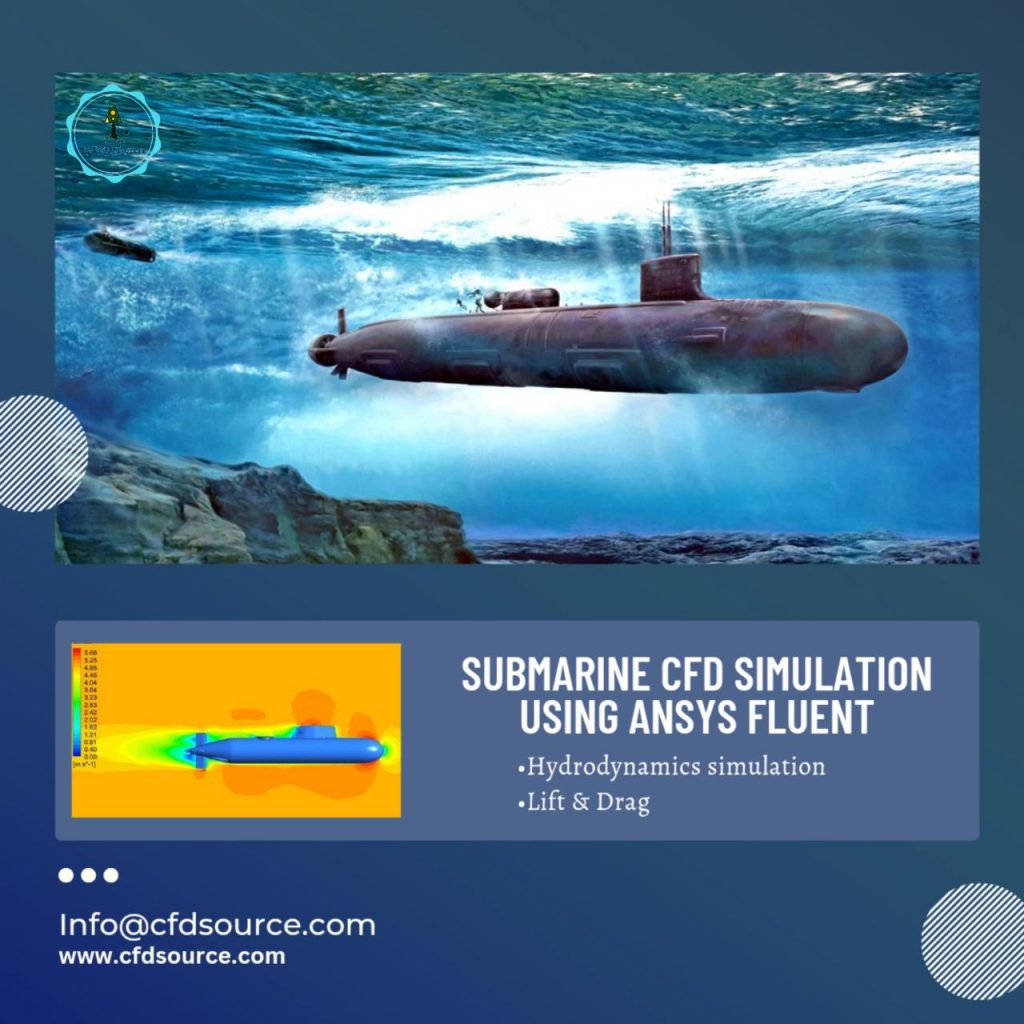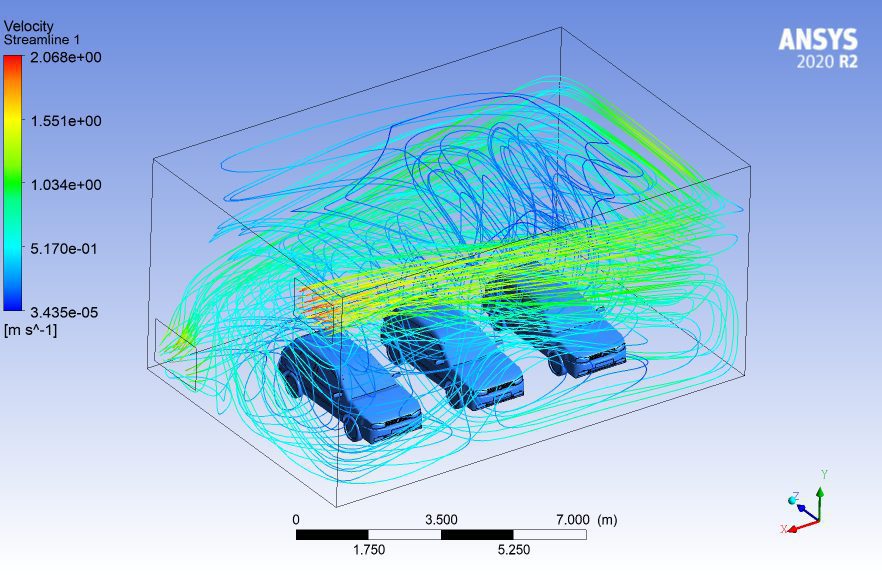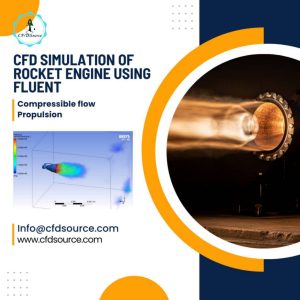CFD Course: If you’ve ever marveled at the aerodynamic performance of an F1 car, or a natural process like the gentle flow of a river or the complex patterns of weather systems, you’ve been impressed by the unique wonders of fluid dynamics. Understanding these phenomena and the ability to simulate and analyze them is the essence of Computational Fluid Dynamics (CFD). In this article, we will explore the world of CFD courses being offered and explain why you should attend.

Introduction to CFD (Computational Fluid Dynamics)
Computational fluid dynamics (CFD) is a fascinating branch of engineering and physics that deals with the complex and surprising world of fluid flow, there are many natural and artificial examples of this, which is considered fluid flow, these examples can The flow of air around the wings of an airplane, the flow of water in the winding river, or even the complex interaction of gases in various industrial processes. To put it at its core, CFD is all about understanding, simulating, and predicting how fluids behave under different conditions and in different environments. It is a field that plays a pivotal role in various industries, including aviation and automobile engineering fields, to meteorology and pharmaceuticals. But what makes CFD unique is its reliance on complex mathematical models, numerical and calculation methods, statistics, and powerful computational tools to accurately simulate these fluid dynamics. Now, starting this journey into the world of CFD, important topics We will examine the basic concepts, programs, and job opportunities of this field.
Importance of CFD in Various Industries
The importance and footprint of Computational Fluid Dynamics (CFD) can be seen in many industries. In the field of aerospace engineering, CFD is like a magic tool for optimizing aircraft aerodynamics, reducing drag and increasing fuel efficiency. It allows engineers to tweak the design of everything from airplanes to Formula 1 cars to make them faster, safer, more durable, and more fuel-efficient. But the wide field of CFD efficiency does not end here. CFD is also used in the automotive industry to improve car design, and engineers not only use it to increase speed and safety, but also ensure fuel efficiency.
Environmental experts use it for modeling and analysis to investigate the spread of pollution and the effects of climate change on the environment. In the pharmaceutical industry, CFD plays an important role in drug formulation and ensures the precise and efficient effect of the drug. The field of application of this knowledge is wide, from measuring the movement of blood flow in the human body to the macro scale of weather patterns. CFD is a widely used tool that allows scientists and engineers to understand the behavior of fluids in their many applications and, if needed, manipulate them in a targeted way.

Advantages of Taking a CFD Course
Enrolling in a CFD course is not just the beginning of an adventurous journey into the exciting world of fluid dynamics, but a transformative experience with many benefits. Navigating this path will, first, equip you with comprehensive knowledge of fluid dynamics, which includes It introduces a wide range, from basic concepts to advanced simulations. Along this path, you will learn the intricacies of numerical methods related to solving and computation, unsteady modeling, and heat transfer, among other fundamental topics. This knowledge is invaluable in industries where CFD is used. In addition, taking a CFD course will strengthen your problem-solving skills.
In the following, you will gain the ability to analyze complex problems that exist in the topic of fluid flow, as well as create effective and practical solutions to solve these problems. Acquiring this skill is a must that can make you very successful in the job market. Finally, you will come across many and effective options of exciting and high-paying job opportunities. As industries fully understand the importance of CFD, the demand of various industries to recruit CFD engineers and experts is increasing, making it a field with promising prospects.
Key Concepts Covered in a CFD Course
A CFD course is designed for extensive research and a comprehensive training course where a large amount of key concepts are taught. One of the basic topics that you will face in this course is the topic of studying fluid properties. This includes understanding how different fluids behave under different conditions, such as viscosity and density. Numerical and computational methods are another important aspect of CFD. Moreover, in this course, you will study the mathematical techniques used to solve and calculate fluid dynamics problems, including the finite element method and the finite volume method.
Turbulence modeling is a complex but essential part of CFD that will be part of your curriculum. It involves predicting and simulating turbulent flows, which is a common occurrence in many practical applications and issues we encounter. Heat transfer is another topic that you will deal with in the curriculum, this topic involves understanding how heat transfers in fluids and between fluids and solid surfaces. Multiphase flows, which deal with situations where multiple phases of matter coexist and interact, are also addressed. These concepts, among other topics and concepts, form the foundation of your CFD training course and provide you with a strong set of skills to tackle real-world fluid dynamics challenges.
Choosing the Right CFD Course
Choosing the right CFD course is a fundamental decision in your research course to master Computational Fluid Dynamics. The number of options available to select from can be huge, but with a conscious and measured approach, you can have a choice that fully covers your goals and moves in the direction of your dreams. Firstly, consider the reputation and credibility of the institution offering the course. Universities and institutions with an excellent track record in engineering and science are often reliable options for you to decide from. It is also necessary to evaluate and review the content of the course. Check whether it covers the key topics that interest you and whether it strikes a balance between theory and practical, real-world applications.
The faculty’s expertise in this subject is equally important to achieving your goals. Instructors with hands-on experience in CFD and its practical applications can provide valuable insight and guidance for training. In addition, the availability of resources such as CFD software, efficient high-performance computing clusters, and laboratories can be very practical and helpful in your learning. Finally, consider your goals and career plans for the future. Now, with that said, are you looking for a CFD course to learn more or advance your career? The answer you have in mind will affect the level and type of course you should pursue.
CFD Course Duration and Structure
The duration and training structures of CFD courses can vary significantly depending on the institution and the specific program they offer. Short courses may take a few weeks and provide a quick overview of CFD principles, while programs are more in-depth and long-term, lasting up to several months. Choosing between these options depend on your prior knowledge and the depth of your understanding of this science. The structures presented during this program usually include lectures, practical simulations and practical projects. The lectures are vital and important for theoretical knowledge and understanding of the theory, as well as understanding the mathematical foundations of CFD.

Simulations play an significant role in CFD training, giving you the ability to put your theoretical understanding and theories you’ve developed into practice. You will be taught how to use CFD software, run simulations and interpret the results properly. Hands-on projects, often aligning your efforts with this subject, enable you to apply your knowledge to real-world problems you encounter, making your learning experience more engaging and impactful. Therefore, when considering a CFD course, it is essential to assess the balance between theoretical and practical components and gauge how well it aligns with your learning style.
CFD Course Curriculum
A CFD course curriculum with an appropriate approach is the basis of a comprehensive education in fluid dynamics. The curriculum offered usually begins with a foundation in fluid mechanics and examines topics such as fluid properties, fluid flow classification, and the fundamental equations of fluid dynamics. After this, you will deal with numerical and computational methods and use the mathematical techniques used in solving fluid dynamics concerns. Turbulence modeling, a complex but vital aspect of CFD, has been thoroughly studied in this field. You will be taught how to predict, simulate and analyze the movement of turbulent flows and then reach a reliable result.
The topic of heat transfer is another integral and fundamental part of the curriculum that is presented to you, which focuses on the topic of thermal energy transfer in fluids and between fluids and solid surfaces. Furthermore, multiphase flows, which cooperate with multiple phases of matter in one of The integrated system interacts with each other and will be analyzed. Blending these core subjects together, you will participate in various activities, simulations, and hands-on projects and apply the knowledge you have acquired in real-world scenarios that we deal with. This course should provide a comprehensive training in CFD and strengthen your skills in both theory and practice of fluid dynamics.
Career Opportunities After Completing a CFD Course
Now, by completing a CFD course, you can see several career options in front of you that are very exciting and lucrative. As applied industries around the world become increasingly aware of the importance of computational fluid dynamics, the demand for CFD experts is increasing. One of the most common career paths in this field is CFD engineering. In this way, experts work on diverse and interesting projects, from designing high-performance airplanes to improving and enhancing the performance of combustion engines. Research scientists also find their place of work in CFD and research in advanced simulations, broadening the field of knowledge of fluid dynamics.
For those who are interested in entering the university to teach, CFD training in the following universities and institutions can become a complete and comprehensive career option for them. In addition to this job, CFD experts are highly sought after in industries where fluid dynamics play a fundamental role, such as the automotive industry, aerospace industry, and the environment and energy sector. The adaptability of CFD skills to different fields allows you to choose a career path that fits your goals, that includes your interests and aspirations and is compatible with it, and it is a field with prospects and opportunities. To become reassuring for growth in the desired profession.
Industry Demand for CFD Experts
The demand for recruitment of Computational Fluid Dynamics (CFD) specialists is always increasing, and there is no sign of decreasing this demand. Industries across the spectrum are increasingly realizing the critical role CFD plays in optimizing designs, reducing costs and consumption, and improving the overall performance of products in their processes. In the aerospace industry, the use of CFD to increase aircraft aerodynamics, a critical factor in fuel efficiency and safety, is a must. In the automotive sector, CFD is also relied upon to facilitate vehicle design and maximize fuel economy.
Environmental experts also use CFD to study the dispersion of pollution in environmental environments, and by using CFD, they help reduce the impact of existing challenges on the environment. Now we give an example from the medical field, in the pharmaceutical industry, CFD is used to ensure Effectiveness of drugs is used in time. As we have seen, the demand for the use of CFD expertise is not limited to a specific field. The fields of its use are many, and it makes CFD specialists in different sectors of industries highly interested. As industries continue to evolve and innovate, the need for experts proficient in CFD will continue to increase, creating promising and secure career opportunities for those who choose to specialize in this field.
Real-World Applications of CFD
Real-world applications of CFD are both diverse and influential. Here are some examples where CFD is making a difference. In the automotive industry, CFD simulations are used to optimize vehicle design, reduce drag, and increase fuel efficiency. This not only leads to the production of environmentally friendly cars, but also saves money in the production process for manufacturers. In the aerospace sector, CFD helps to design aerodynamic aircraft with less fuel consumption and helps to reduce the emission of greenhouse gases in the atmosphere.
In the energy industry, CFD is employed to model and improve the performance of power plants, reducing energy wastage. Environmentalists use CFD to simulate air and water pollution dispersion, aiding in the development of strategies to combat pollution. The pharmaceutical industry relies on CFD to design drug delivery systems that ensure medications reach their intended targets efficiently. Beyond these sectors, CFD has applications in areas as diverse as architecture, urban planning, and even the food and beverage industry. The versatility of CFD in optimizing processes and designs makes it a powerful tool with far-reaching effects on our daily lives.
CFD Software and Tools
A critical component of any Computational Fluid Dynamics (CFD) course is becoming proficient in the use of CFD software and tools. These software applications and tools are the workhorses of the CFD industry, enabling engineers and scientists to simulate and analyze fluid dynamics. Among the most popular CFD software packages is ANSYS Fluent, known for its versatility and extensive capabilities. It allows users to model a wide range of fluid flow scenarios, from simple to highly complex. Another widely used tool is COMSOL Multiphysics, which specializes in Multiphysics simulations, enabling users to study how various physical phenomena interact.
Open FOAM, an open-source CFD software, is known for its adaptability and extensive user community. It’s a valuable resource for those who prefer open-source solutions. These are just a few examples, and there are many more CFD software packages available, each catering to specific needs. Mastering these tools is essential for CFD professionals, as they form the foundation for conducting simulations, analyzing results, and making informed decisions in various industries.
Conclusion: CFD analysis online course
In conclusion, Computational Fluid Dynamics (CFD) is a captivating field with vast applications and exciting career prospects. A CFD course equips you with the knowledge and practical skills to excel in this field, making you a valuable asset to industries spanning from aerospace and automotive to environmental studies and pharmaceuticals. The demand for CFD experts continues to rise, ensuring promising career opportunities. Real-world applications of CFD are diverse, impacting everything from designing energy-efficient vehicles to addressing environmental concerns.
Proficiency in CFD software and the art of simulation are vital skills in this field. Practical experience through internships and projects is where you apply your knowledge and refine your problem-solving abilities. To succeed in your CFD course and subsequent career, dedication, curiosity, practice, networking, collaboration, and perseverance are your guiding principles. As you embark on your CFD journey, you’ll find a world where the complexities of fluid dynamics become your playground, and your ability to unlock their secrets can shape the future of various industries.



